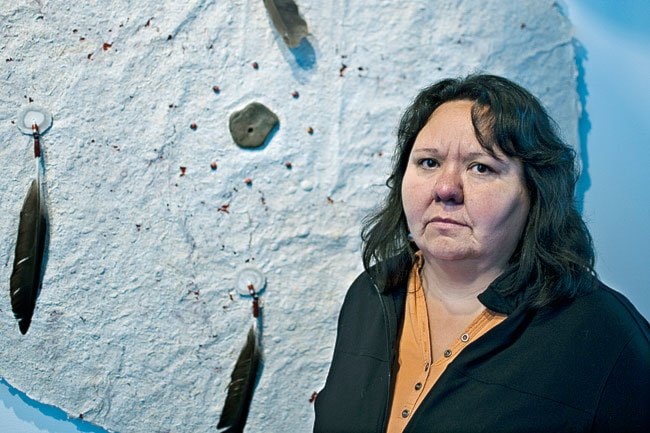There are only two people left in the world who can fluently speak the Tr’ondek Hwech’in First Nation’s language.
And both elders, Percy Henry and Edward Roberts, are getting on in age, said Jackie Olson, the aboriginal government’s heritage director.
“We’re really feeling that crunch,” said Olson. “We’re at a critical point. We’ve been really brainstorming on how we can use the language on a more everyday use and connect with the youth and our young people. We’re trying to think outside of the box.”
The heritage department, along with four children between the ages of eight and 10 years old, made a movie.
Angie Joseph-Rear, the First Nation’s language expert, collected and combined a few shorter traditional stories to create a longer Story of the Crow.
Together with a filmmaker, the children then built sets and props and illustrated the story with an 11-minute film using claymation, animation, puppetry and stop-motion techniques.
Joseph-Rear narrated the story, weaving Han words throughout. Each time a Han word was used, the film would frame the word being written in sand.
“People need to hear the language and they need to have the language around them,” said Olson. “This is one way of using modern technology to just get snippets out there. We need to change our attack at regaining the language.”
Han is taught in Dawson City’s school, but only up to a certain grade. That leaves youth encouraged, but with nowhere to go, said Olson.
The Tr’ondek Hwech’in’s Han language, which is a different dialect than the Han spoken by the First Nation’s cousins in Eagle, Alaska, is the most endangered First Nation language in the Yukon.
Tagish has already gone extinct and the other six traditional languages in the territory are not thriving.
Every single Yukon First Nation language is in decline, dying off with the elders who grew up speaking it.
Upper Tanana, spoken along the Alaska border in southwestern Yukon, is “very near extinction,” according to assessments done by the Yukon government from 1998 to 2003.
Approximately one in every five Tlingit people cannot speak their ancestral language at all, and while there are still a fair number of people who report that Southern Tutchone is their mother tongue, that language is also deteriorating because people are not using it, the report said.
Most fluent Northern Tutchone speakers were over the age of 50 and not passing on the language when the government study was conducted. And only a quarter of Kaska speakers said they could speak their language fairly well. Finally, despite its speakers’ isolation, the Gwich’in language in Old Crow is in great danger, the report said. The parent generation between 25 to 44 years old represents the largest proportion of people who do not understand Gwich’in. English has taken over as the main method of communication.
“Every language in the Yukon is endangered,” said Marilyn Jensen, co-ordinator of language revitalization programs with the Self-Government Secretariat at the Council of Yukon First Nations.
“Each community is pretty clear on how many fluent speakers they have left and all of the fluent speakers are mainly all elderly. Having the natural process of learning your own language from your own grandma and parents will just be gone. The rest of us are learning it as a second language, from the internet or from books.”
Not a single Yukon First Nation language has more than 30 fluent speakers left, said Jensen. Most have fewer than 20.
The most common cause for losing these languages is simply that they are not being used. The reasons for that can be summed up in one word, said Jensen: colonization.
“Every community in the Yukon was impacted by residential schools,” she said. “Literally, the language was beaten out of our people.
“There’s a large amount of First Nations people in the Yukon, around my mom’s age, that can hear the language and understand, but it just doesn’t come out of their mouths because it was so conditioned not to speak it. There’s this stigma and it just doesn’t come out.”
On Tuesday, Jensen was heading to Mayo for the second week-long language immersion camp this year.
Isolating participants with fluent speakers and encouraging their only communication to be in the traditional language is one proven method of regaining language. Another is language nests, or daycares, which work with babies and young children in traditional languages.
It was the proven technique with the Maori in New Zealand, who brought their language back from near-death. Jensen hopes to establish language nests throughout the territory soon.
“Other people have done it,” said Jensen. “Our language is so intertwined into our identity, our culture - everything about us. I personally don’t want to be a part of the generation that says, ‘Oh yeah, we let our language die because it was too hard to save it.’
“Yeah, you can dance and you can sing ... But it’s a whole perception of the world that cannot be explained in someone else’s language.
“We have one last go here to fight for something that is so important.”
The issue of protecting traditional languages was raised in the territorial legislature by Vuntut Gwich’in member Darius Elias, from October to December 2009. On December 9, Elias tabled a motion for an independent, non-partisan commission on Yukon aboriginal language protection. In April, 2010, then-premier Dennis Fentie signed an agreement with the Council of Yukon First Nations for a one-time cheque of $2.5 million for Jensen’s programming. There have been no negotiations for continued funding.
The Tr’ondek Hwech’in paid for its film through a Yukon Arts Centre program called Culture Quest.
It hopes to make a second version of the film, with older children, using more Han words, in the near future.
Contact Roxanne Stasyszyn at
roxannes@yukon-news.com.
